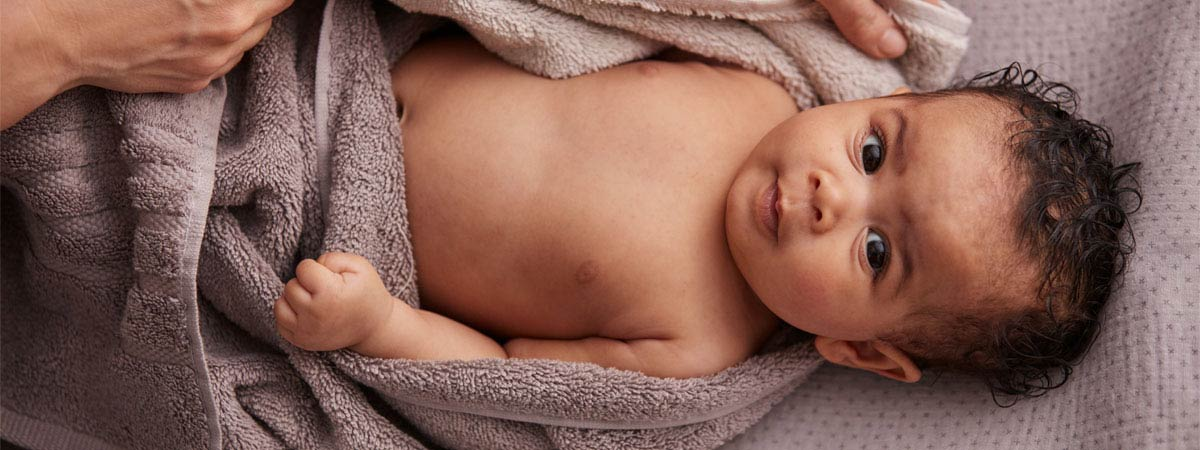
Baby care
Here you can find useful tips and advice on caring for your newborn baby's nails, navel, hair and skin
Nappy changes, being washed and being cared for are cosy and intimate moments for your baby.
Familiar rituals and repeated routines, for example on the baby changing table, give your baby a sense of security.
Tummy button
The remains of your baby's umbilical cord will shrivel up, smell a bit – and finally fall off of its own accord. The stump usually falls off after about 8 to 12 days.
The baby's navel needs to be kept clean. You can wash it carefully with a cotton bud dipped in ordinary water and then wipe it with a dry cotton bud. There are no nerves in the umbilical stump, so the baby won't feel anything when you wash it.
It is completely normal if the navel bleeds and gives off a little fluid. But if it gets red and swollen, starts smelling more and gives off even more fluid, it might be getting infected. In that case, contact the paediatric centre.
You can bathe your baby even if the umbilical stump hasn't fallen off yet.
Here you can read about your baby's skin.
Washing or bathing your baby
Give your baby a bath once or twice a week. Read tips on bathing your baby, or watch Libero's bathing video.
How to change a nappy
When putting a clean nappy on, make sure it isn't pressing against the umbilical stump, if this hasn't dropped off yet. Libero's smallest nappies feature an extra thin "navel care" panel, to allow the navel to heal well.
Position your little boy's penis pointing downwards to prevent him peeing in the direction of his navel.
Or click to Libero's website to watch our video on nappy-changing tips.
Here you can also read about what your baby's poo may look like to start with and what to do if your baby's bottom develops a rash.
Hormone rash and other spots
Hormone rash consists of small red spots that your baby may get during its first few months. The spots may have yellow heads and look like little pimples. Read more about spots, rash and dry skin on babies.
Cutting your baby's nails
A newborn's nails can be long and sharp, and the infant risks scratching its face when it waves its arms. It can initially be difficult to see where the nail begins and the skin ends. For this reason, trimming their nails with scissors is tricky. It's better to file the nails or carefully tear off loose edges.
When the nails become too hard to tear – after about a month – you can start cutting them straight across with nail scissors or baby nail clippers. You can trim the baby's nails while it is asleep, ideally straight after a bath when they are a bit soft.
Washing irritated eyes
The baby's eyes can be a little swollen for the first few days of its life, but this usually passes by itself. Its eyes can also become irritated, causing them to water. You may need to wipe them after the baby has been sleeping. Wipe them from the outer edge to the inner corner with a soft swab dipped in water, or with saline solution from the pharmacy.
If the eye problems continue, there may be a infection. In that case, contact the paediatric centre.
Your baby's hair
Some babies are born with a big shock of hair, while others are almost bald. However much hair they have, you can comb it gently with a fine-tooth comb, first against the direction of growth and then in the right direction. This prevents cradle cap. It is easiest to comb the hair after a bath or after washing the baby's head with lukewarm water.
You don't need any shampoo to wash your infant's hair. It's enough to put a little baby oil in the baby.
Cleaning your baby's ears
Clean the outside of your baby's ears when necessary, maybe about once a week. Libero has soft cotton sticks specially for babies and toddlers.
Avoid pushing the stick into the baby's ears. Don't try to remove the wax from its ears. If you insert a cotton stick into its ear, you risk pushing the wax into the ear canal and creating a wax plug.
Start giving the baby vitamin D after a week
For the first two years, your baby needs extra vitamin D. Give your baby five vitamin D drops a day, all year round. The recommendation is for your baby to start taking vitamin D drops when it is a week old.
Wait before introducing a dummy
Babies have a natural urge to suck, and the mother's milk production adapts to the baby's individual needs. It is best to avoid a dummy until a breastfeeding routine is established.
You can try introducing a dummy once the baby has established a good sucking technique and you are sure it is getting the amount of milk it needs.
